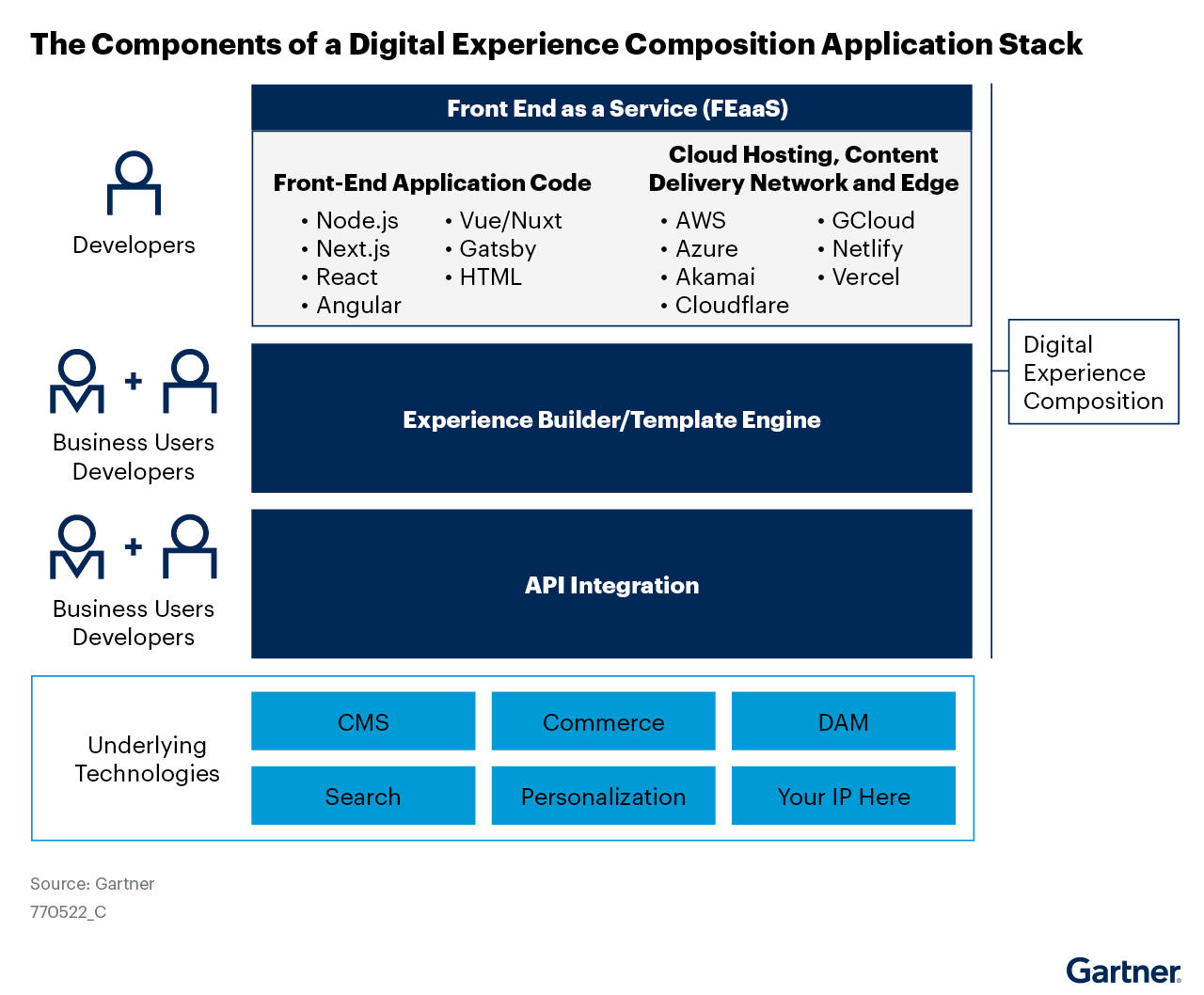

Aug 03, 2023
Potential buyers searching for a new platform to manage their digital experiences can sometimes feel overwhelmed by the terminology that awaits them. From headless CMSs to monolithic and composable DXPs, the digital experience and marketing technology stacks can seem complex if you don’t have the right support to explain everything and whether it’s relevant to your business.
New terminology in the headless and DX space is nothing new, and DXC has joined the party. But what exactly is it, and why are vendors and analysts discussing it as the next stage for leading enterprises?
We’ll explain it in this article.
Digital Experience Composition Explained
Digital experience composition (DXC) refers to a set of tools that allow developers to build digital experience solutions and then hand them over to business users for day-to-day management.
Developers build and orchestrate these experiences using headless or composable approaches, combining headless CMSs, commerce, search, analytics, and other tools with each other using APIs. They can give these solutions to business users who manage things independently using no-code tools.
DXC tools are made up of three components: front-end-as-a-service tools (FEaaS), an experience builder, and an API integration mediation layer.
DXC Components
Front-end as a Service
FEaaS, or Front-end as a Service, provides a presentation layer for browser-based experiences. This presentation layer can be created using various frameworks like Angular, React, Vue/Nuxt, Next.js, Gatsby, and others.
FEaaS helps accelerate the development of single-page applications, PWAs, and hybrid static and dynamic solutions. By utilizing FEaaS, developers can delegate the presentation layer to experts while they focus on building application functionality.
Experience Builder or Template Engine
Experience builders empower business users to manage the layout and composition of web content and functionality. This is achieved through a drag-and-drop or a WYSIWYG interface, with the ability to configure component behaviors. Experience builders also include a templating engine and an integrated development environment for developers to create and orchestrate visual layout components. Digital content experiences can be created faster without waiting on technical teams for every update. Business users take control of the content and presentation of their digital experiences, while experience builders improve the agility, flexibility, and relevance of digital experiences.
API Orchestration Layer
A mediation layer for API integration between multiple technologies connects and transforms relevant assets, such as content, products, and images, or interactions, such as forms, search, access control, and shopping carts, from their source system to a unified digital experience. It also orchestrates between different components, enabling seamless and personalized digital experiences for end-users.
Vendors can differentiate themselves by offering pre-built, productized connectors to leading vendors in core digital experience segments, allowing organizations to quickly connect and integrate their various systems and technologies. For example, headless CMS vendors offer a marketplace with integrations to analytics and commerce tools, CDNs, and other software that comprise the technology stack.
Why DXC Is Becoming a Talking Point
The digital experience landscape continuously evolves as customer demands change and vendors adapt their offerings to meet those needs better. Currently, there are three primary drivers behind the DXC evolution.
-
All-in-one DXPs offer all-in-one benefits but at a higher cost and often limited flexibility
While several enterprises can benefit from an all-in-one or suite solution, these platforms are often out of the financial reach of smaller or medium-sized enterprises due to the initial implementation and ongoing costs. Also, these solutions always don’t integrate well with other tools outside of the suite, resulting in limited flexibility.
As Gartner points out in its 2023 Magic Quadrant for Digital Experience Platforms, “digitally mature prospects are looking to compose their own DXPs from modular, independent capabilities, and DXC is positioned as the point of composition for digital experiences.” Rather than seek out all-in-one solutions, these businesses want the flexibility to build their own as they see fit.
-
Headless is still not as easy to implement as businesses would like it to be
Headless solutions, whether a headless CMS or DXP, offer numerous benefits, such as delivery to multiple channels and integrating with other tools via APIs. However, going headless isn’t always as easy as it seems, often requiring a robust development team to be done effectively. Per Gartner, “going composable remains very much pro-code, and thus advanced digital maturity is required in those taking this path.”
Business users want more control and developers more freedom
Organizations have begun to adopt composable solutions when building their technology stacks. The end of composability is to make everything no-code, placing more control in the hands of business users. This is a challenge that DXC seeks to solve.
While these factors drive the focus toward DXC, it is currently meant for digitally mature organizations with developer and architectural skills to build and continually maintain the solution. Many businesses will be satisfied with just a CMS and commerce tool and won’t need such extensive capabilities. Plus, for B2B businesses, DXC can be complex as deeper integration with multiple internal systems and management user interfaces and workflows are required.
Benefits of DXC
No Vendor Lock-In
DXC solutions help reduce this vendor lock-in by enabling companies to select the best vendors and technologies for each packaged business capability. With DXC, organizations can leverage the strengths of various vendors and technologies, allowing them to create more agile, scalable, and flexible digital experiences that meet their users’ unique needs and expectations.
Omnichannel Content Delivery
Omnichannel content delivery is a key benefit of DXC because it allows organizations to deliver consistent and personalized content across multiple channels and touchpoints by pulling together various tools, including CMS, commerce, search, and more. Users can seamlessly switch between channels without experiencing any disruptions in the content or user experience. Businesses can create a cohesive brand experience across all channels, building stronger customer relationships and increasing brand loyalty.
Flexible and Modular Architecture
With a flexible and modular architecture, organizations can easily add or remove components, features, and functionalities, enabling them to create personalized and relevant digital experiences that meet their users’ unique needs and expectations.
Faster Time to Market
DXC empowers business users, enabling companies to bring their digital experiences to market faster, respond to changes more quickly, and optimize customer value more efficiently. With DXC, campaigns can be launched across multiple channels without business users requiring assistance from developers every time they want to try something new.
How Leading Vendors Are Embracing DXC
Digital experience composition is the next stage of composability and probably where many vendors will end up in some capacity. So where are current industry leaders focusing their efforts?
-
Sitecore: Currently leaning into composability and DXC as they seek to provide easier integrations with third-party vendors.
-
Optimizely: Offering stand-alone products but leaning toward a suite-approach rather than embracing composability.
-
Adobe: Focusing on the connectivity strength of their suite approach.
-
Headless Vendors: Leading vendors such as Contentful, Contentstack, Kontent.ai, Hygraph, and others have lean headless CMS solutions, which are ideal for the experience layer of DXC and integrating with other tools to handle additional services.
-
DXC Platforms: Vendors such as Uniform and Stackbit are positioned as DXC platforms focusing on swiftly integrating the various services that power the digital experience.
Getting Expert Help to Compose Digital Experiences
Oshyn understands that this world is constantly changing and confusing for enterprises. Do you need a DXC? Is the suite you started migrating to going to last as long as you thought it would? Should you go with this headless CMS, that composable DXP, or something else entirely?
We have the experience to help you navigate and choose the best option for your business. We understand the landscape with over two decades of experience working with leading vendors in the industry, from Sitecore and Adobe to Optimizely and others. We can point you to where you need to go and what will drive the most business value. We help you plan not just short-term but medium and long-term as well.
Read our composable DXP article to get a better understanding of composable architecture, and contact us for further assistance.










